How to close a radiator in the room: the point of view of sanitary ware
Table of contents
- 1 As the battery warms
-
2 Faults heaters
- 2.1 Intersection leak
- 2.2 Flow through the locknut
- 2.3 Fistula on the thread
- 2.4 Airlock
- 2.5 radiator siltation
-
3 Requirements for decor
- 3.1 materials
- 4 A little common sense
- 5 conclusion
Greetings, comrades! Today we will talk about how to decorate a radiator in the living room. As your humble servant in the recent past was a plumber, any decor will be discussed from the standpoint of practicality - heat radiator and its maintainability.
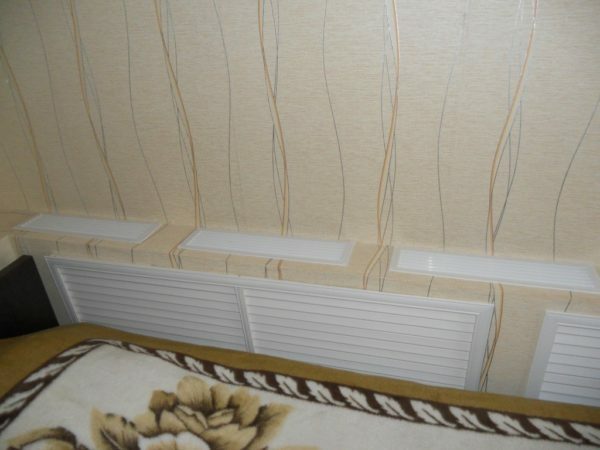
In the photo - a perfect example of how not to close the heating radiator. Why - I'll explain later.
As the battery warms
Any heating appliance gives off heat premises to be heated in two ways simultaneously:
- convection. The air is heated by direct contact with the radiator surface and due to the decreased density when heated is displaced upwardly by colder air masses. Cooling down, it goes down again, reheated upon contact with the radiator - and so on ad infinitum;
- thermal radiation. Infrared rays propagate within the line of sight and cause heating of objects near the heater.
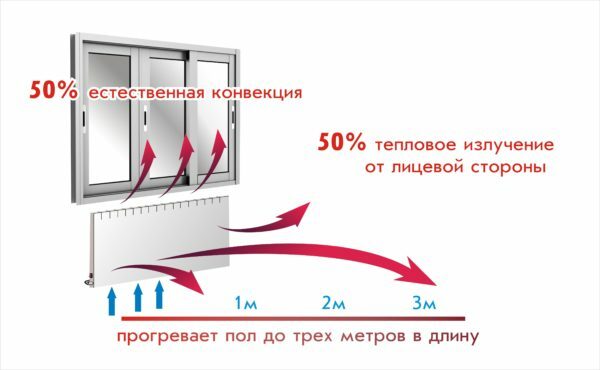
Convection and infrared radiation on an equal footing participate in the radiator heat exchange with its environment.
The predominance of a heat transfer method determined by the configuration of the heater and its temperature. For aluminum panels with developed finning convection prevails, for the fins - radiation.
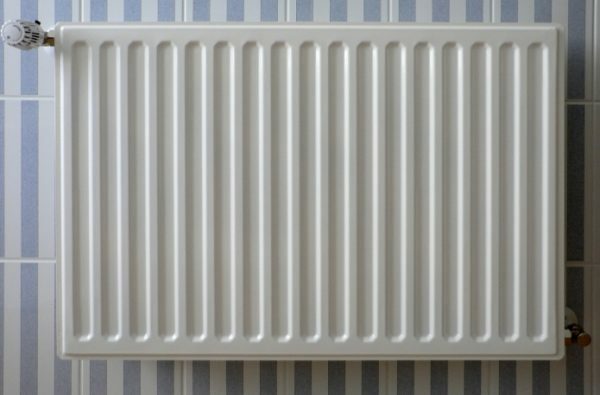
Plate heating radiator gives up heat primarily by radiation due to the small area of thermal contact with the air.
To no barriers do not impede convection radiator located under the window a certain way:
- Distance from the sill must be equal to at least 6-12 cm. The flow of heated air must be free to rise up, providing an effective and uniform heating volume of the space;
- Between the radiator and the wall there is a gap of 2-3 centimeters. It provides air flow, heated by contact with the back side sections;
- Between the battery and the floor also requires clearance (at least 8 cm): it ensures the free flow of cool air, the heated replacement.
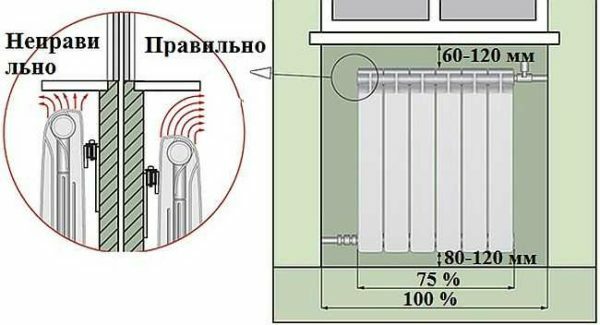
Location radiator podokonnoj niche must ensure the free movement of convection currents.
In order not to hinder the heat transfer by radiation, the battery should not be closed from the main volume of the room furniture and blackout curtains.
Faults heaters
The idea to close the screen there is a battery, as a rule, the owners of the cast iron radiators Soviet model. Indeed, apparently they are quite unsightly. Initially unattractive appearance is often compounded by the influx of long-standing layers of paint - irregularly superimposed and partially burned.
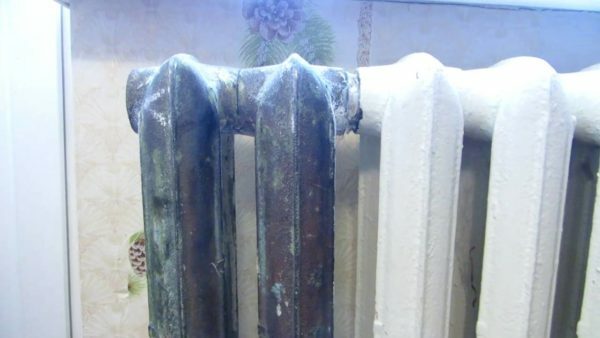
The appearance of a Soviet-style cast-iron battery - the nightmare of any designer.
Now - the bad news. Cast iron radiators are a number of common problems that require free access to them.
Intersection leak
The essence of the problem: Paronitovye gasket between the cast iron sections are no different elasticity. Over time, they are becoming more stringent.
When heating sections in the heating season gasket is compressed due to thermal expansion sections, and after cooling, no longer returns to the former size. Plug-in connection leaking.

Leak at the connection sections - a common ailment of sectional radiators.
elimination: Extreme sections are disconnected, and the current pin-connection change both pads. The work requires access to a hollow radiator caps on the end of the radiator. If you close the battery dull screen and even more to hide it in a box, unscrew the stopper and remove the section will be simply impossible.
Flow through the locknut
The essence of the problem: Rotted or burnt organic preroll under locknut on one of podvodok ceases sealing threaded connection.
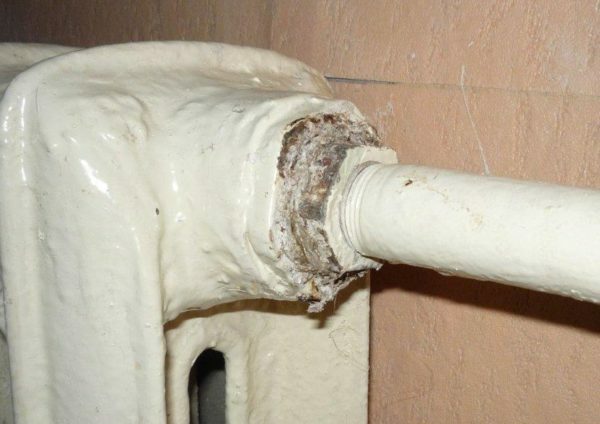
Threaded connection with eyeliner pass radiator caps often become leakage place.
elimination: Heating at a reset riser locknut turns on and rewound several turns sanitary flax or other reeling. If you close the screen a radiator or duct, access to the liner will be extremely difficult. Turn the tube or pipe wrench in a confined space can not.
Fistula on the thread
The essence of the problem: Cast iron radiator is connected to the liner sleeves - cut her long thread. The steel is subject to corrosion. Through fistula appeared primarily in areas with lower wall thickness, that is the hollows threads.
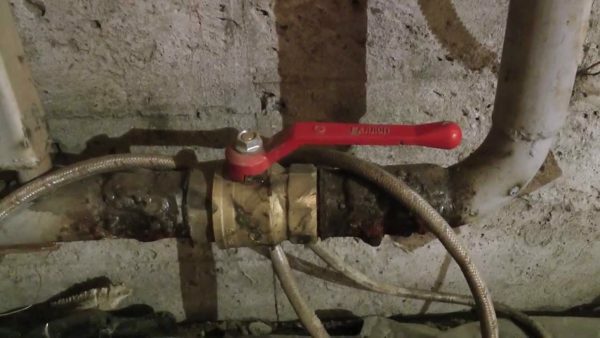
Fistulas arise where the pipe wall thickness is minimal - of the thread in the depressions.
elimination: When a reset heating riser hoses cut off at the beginning of the thread, and it electric or gas welding is welded a new eviction. If you close the radiator non-removable screen or hide them in a box, the welder will not be able to get to the problem area eyeliner.
Box or the screen for the radiator often hides the problem of property owner: a leak there, but you can not see it. The presence of the radiator defect or eyeliner you learn from flooded neighbors, or in case of flooding his apartment, when small fistula in the tube becomes a source of a serious leak.
Airlock
The essence of the problem: Heating circuit after reset when restarting the air remains therein. Trapped air impede circulation risers.
elimination: Air is vented through the so-called Majewski cranes installed on the top floor of each riser. Cranes often are mounted in the upper blank radiator caps. And in this case, to run the riser need free access to the battery.
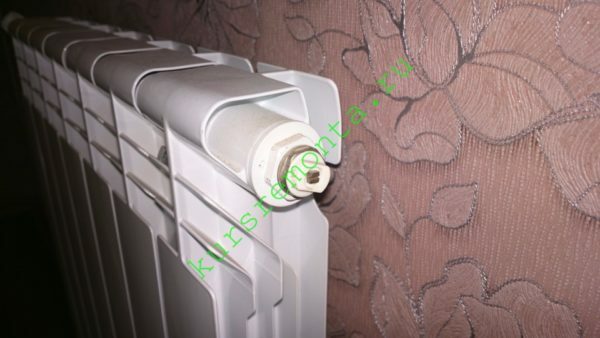
Majewski crane for removal of air, which prevents the circulation of the heating risers.
radiator siltation
The essence of the problem: Silt and sand carried by the coolant gradually accumulate in the lower reservoir distant from the liner sections - on the site, where the water velocity is minimal. The last section of the stop warming.

If you open the old battery, you may find that its end section is completely clogged with silt.
elimination: Yl washed out of the battery through the exhaust valve. To a crane mounted instead of one of the deaf radiator plugs clings hose through which water is discharged into the sewers. And to set the promyvochnika, and for most washing need access to the end section.
Requirements for decor
So, how to hide the battery in an apartment without compromising their functionality and maintainability?
- Plasterboard boxes around batteries - strictly prohibited. This box dramatically reduce heat transfer panels, limiting the convection air. In the absence of a heat meter, you will pay the full amount of receiving less heat you;
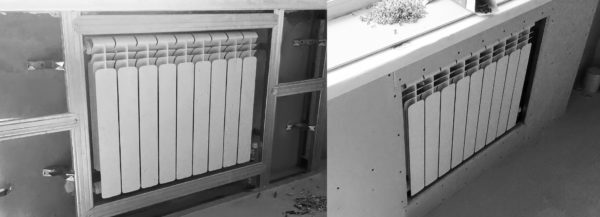
Plasterboard box will minimize battery heat and deprive you of access to it for maintenance and repair.
- The larger lumen area in the screen - the better. Through these gaps will be warm air and radiant heat;
- The solid horizontal shelf on top - a bad idea. It will limit the movement of the ascending air stream;
- decorative screen material should have a maximum thermal conductivity. Warmed up, he will become a source of heat, heated room due to infrared radiation;
Exception - screens that are set to protect children from burns. For obvious reasons, their front surface does not heat up.

Bathroom in the kindergarten. Wooden shield protects children from burns when in contact with the battery.
- Ideal - screen, transparent in the infrared spectrum. Permeability to IR rays possesses, in particular, ordinary glass;
- The back surface is opaque to infrared rays screen should be as dark, ideally - coal-black. The black surface absorbs the maximum amount of heat. White and mirror, on the contrary, reflects the radiation over the entire spectrum;
- Any decor should be easy to remove. Sooner or later, the battery will require maintenance or repair.
materials
From what we can make a decorative screen? I will give an assessment popular content from the point of view of the requirements set out above.
| Picture | The material and its properties |
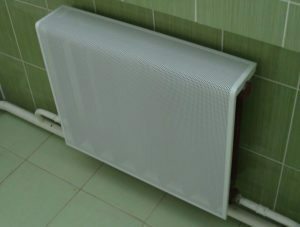 |
metals: Metal screens (aluminum and, to a lesser extent, steel) have excellent thermal conductivity. They are impervious to heat radiation, but upon heating are capable to become a source of infrared rays. The most favorable construction - metal mesh on a light frame. |
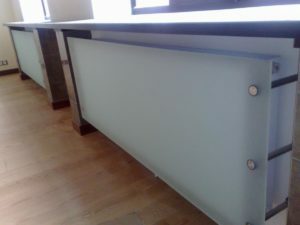 |
Glass: Glass screens are transparent to thermal radiation. The front surface is heated to a much lower as compared to the temperature of the radiator, which makes the glass material safe for families with young children. When installing the screen above and below it must remain gaps for air convection. The distance from the radiator - at least 2-3 cm. |
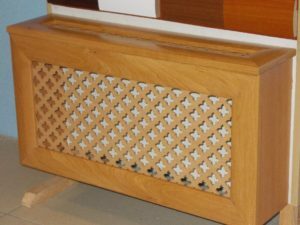 |
Wood: Minimum thermal conductivity and opacity in the infrared spectrum. Prolonged heating and humidity fluctuations and rassyhaetsya timber deforms or yields cracks. Not the best material. |
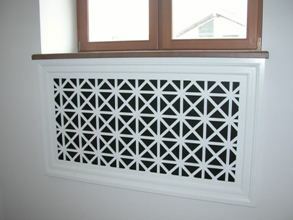 |
Laminate: It has all the properties of wood but, in contrast, retains a stable geometry under heating and humidity fluctuations. Due to the low thermal conductivity can be used in children's rooms. |
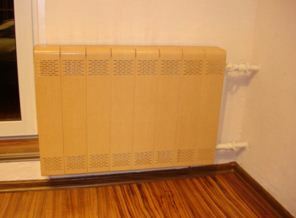 |
plastics: All polymers are characterized by low thermal conductivity and opacity to radiant heat. At prolonged heating to 80-90 degrees plastic degrades and becomes brittle. |
A little common sense
Comrades, let us turn to common sense. Why do we buy or produce their own hands a decorative screen for the batteries?
The answer is obvious: to be beautiful. Dull kind of cast-iron sections clearly not decorate your home.
And what prevents to change the cast-iron battery on modern bimetallic? Its appearance is much better. The buyer will receive a bonus increase in temperature in the living room or the kitchen: heat bimetal section is one third higher than cast iron (190-205 watts vs. 140).
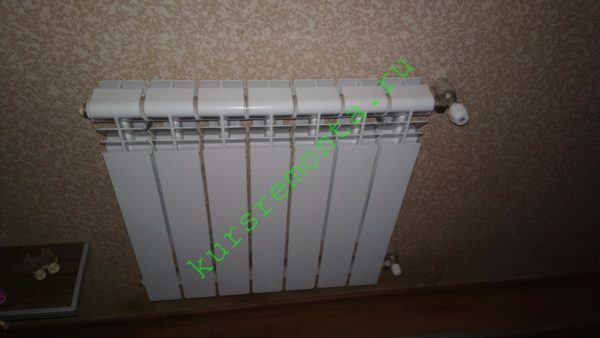
Modern sectional radiators fit perfectly in any design.
You think that a replacement would be too expensive? I dare to disagree. Referring to the catalog online store Leroy Merlin:
| Picture | Description |
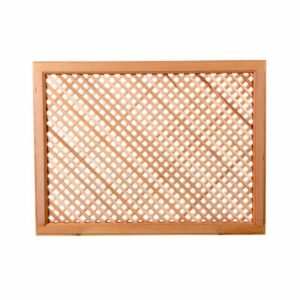 |
Screen Battery. Size - 63h83 centimeters. Price - 2316 rubles. |
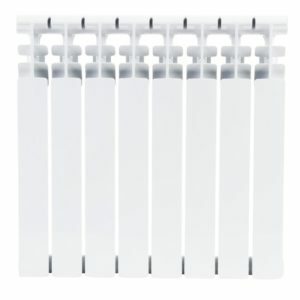 |
Bimetallic radiator. Size - 8 sections. Price - 2295 rubles. |
So, the best way to decor of old cast-iron batteries - to replace them with new ones.
conclusion
I hope that my tips will help dear reader to make your home cozy and warm. As usual, you can find additional information in the video in this article. Feel free to comment on and share their own experiences. Good luck, comrades!


